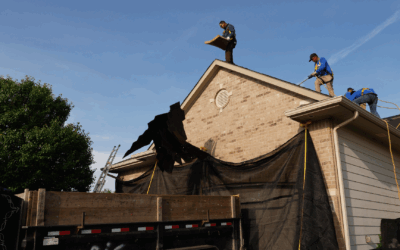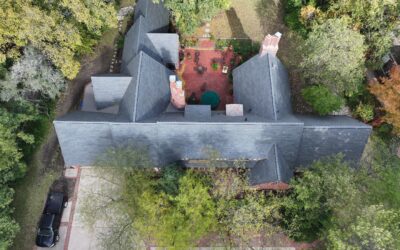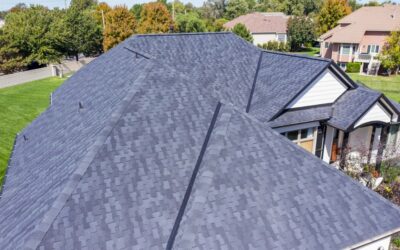A pitch multiplier is a particular number that allows you to find the total surface area of your roof without having to climb up there with a measuring tool. The idea is simple, but the process may be complex. It involves multiplying this pitch multiplier by the area covered by a sloping roof, to obtain the total surface area of the roof. This multiplier will greatly assist, and keep you safe as well!
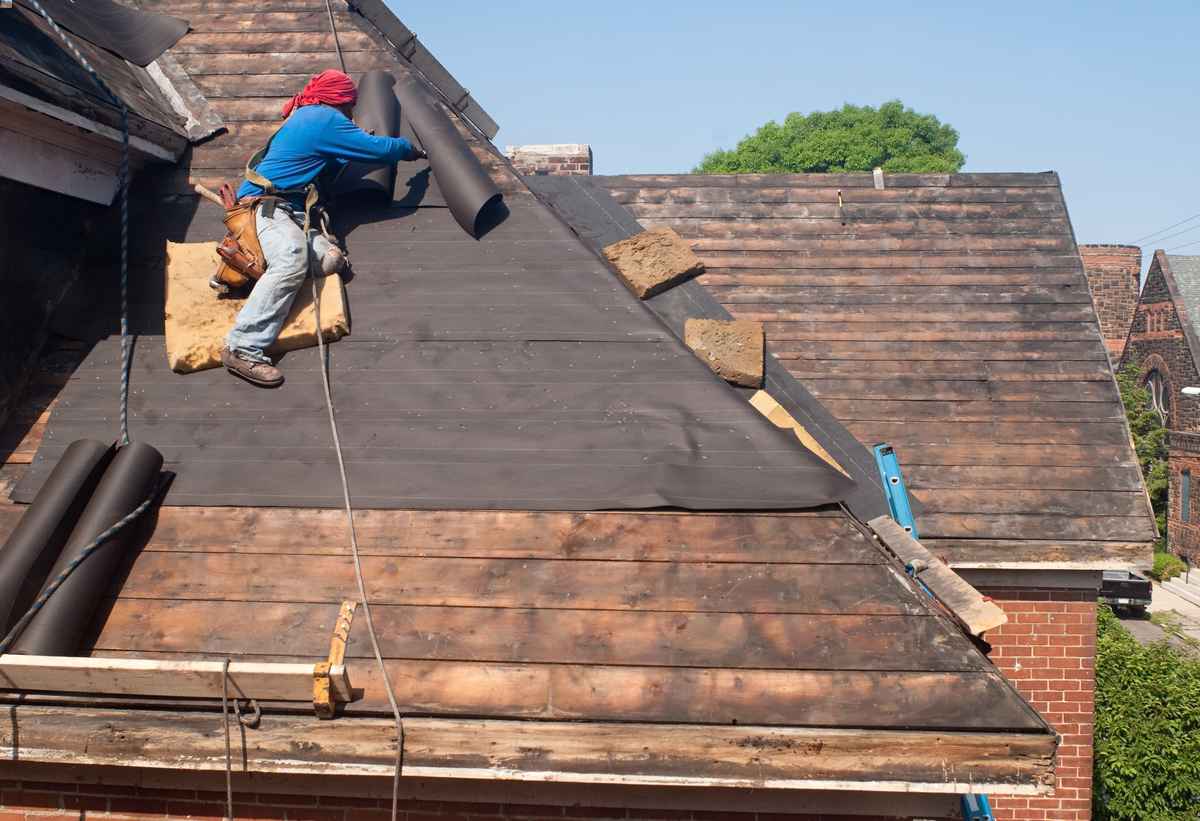
Again, the idea is simple. The formula for the pitch multiplier actually comes from the famous Pythagorean Theorem which states:
- a2 + b2= c2
- The “a” is the Rise of the roof
- The “b” is the Run of the roof
- The “c” is the Rafter or hypotenuse.
- After solving this equation, it resolves to this:
- Pitch Multiplier = c ⁄ b
The following chart is an excellent guide to roof pitch, angle, and the corresponding pitch multiplier:
- 1 ⁄ 12 4.76° 1.0035
- 2 ⁄ 12 9.46° 1.01
- 3 ⁄ 12 14.04° 1.0308
- 4 ⁄ 12 18.43° 1.05
- 5 ⁄ 12 22.62° 1.08
- 6 ⁄ 12 26.57° 1.12
- 7 ⁄ 12 30.26° 1.16
- 8 ⁄ 12 33.69° 1.20
- 9 ⁄ 12 36.37° 1.25
- 10 ⁄ 12 39.81° 1.30
- 11 ⁄ 12 42.51° 1.36
- 12 ⁄ 12 45.00° 1.4142
The pitch is explained like this: if for every 12 inches, the roof rises by 5 inches, then the slope will be 5/12.
How can I use this information to benefit me as a homeowner? You can use this simple method to make sure your roofing contractor is honest and reliable in their calculations.
If a home measures 20 x 40, and has a 7/12 roof, then calculate the slope of the roof this way:
- Multiply 20 x 40 which equals 800
- Find the value of 7/12 from the table above. That multiplier number is 1.16
- Multiply Step 1 and Step 2 (800 multiplied by 1.16)
- The value arrived at 928 reflecting the square feet of the roof.
Through the help of the above table and example, your roof can be measured. This can be helpful when designing an addition, installing skylights, or cutting new rake boards.
If you desire to keep the complex math tucked away in the high school memory block of your brain, then contact us for assistance! We are Rhoden Roofing LLC of Wichita. We have the knowledge and experience in figuring out pitch, slope, and multiplier information. We don’t mind doing the calculations!
Understanding your roof’s pitch is like reviewing an itemized bill: it reveals exactly what you’re paying for and prevents contractors from inflating costs deliberately or through miscalculations.
How Roofers Measure Roof Pitch Accurately (Without Climbing the Roof)
For penetrations and walls, we use a traditional tape measure. To determine lineal feet of perimeter-based material (e.g., drip edge and starter), hips, ridges, and more, we use EagleView.
Think of EagleView as a digital tape measure that works from 2,000 feet in the air, precisely measuring each ridge, valley, and slope in seconds instead of hours. While we don’t mind doing the math, tools that do the math for us save time and money.
EagleView captures aerial imagery using sensors that are attached to aircraft. These aircraft image oblique angles, capturing dimensionality that provides more accurate measurements. To put in perspective how articulate these cameras are, they capture 70 times more detail than images captured from the commercial satellites used by Google Earth. This allows roofers to get accurate reports for a roof’s total surface area.
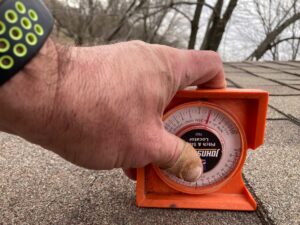
While most reputable contractors verify roof pitch with level tools, using tools like EagleView enables roofers to spend less time getting measurements and more time designing roofing solutions.
How a Small Roof Pitch Error Can Cost You Hundreds
The pitch multiplier tells us the extra surface area between a roof with no slope and a roof with slope. A minor pitch inaccuracy snowballs into inaccuracies for the entire project. For this example, we’ll assume that you have a 5:12 pitch and a 2,000 square-foot footprint. A 5:12 roof requires 1.08x more material than a roof with no slope while a 6:12 roof requires 1.12x more material.
To determine how much extra material a 6:12 roof would require, we’ll multiply your house’s footprint (2,000 square feet) by your 5:12 pitch multiplier (1.08).
- 2,000 x 1.08 = 2,160 square feet
If your roof is inaccurately quoted as a 6:12 roof, we would multiply your house’s footprint by the 6:12 pitch multiplier (1.12).
- 2,000 x 1.12 = 2,240 square feet
A three degree difference results in an 80 square foot difference in total roof area.
At the time of publication, acquiring materials for and installing a bundle of our standard shingles costs $48.26. Each 100 square feet of roof area requires approximately three bundles of shingles. So, for 80 extra square feet:
- 8 x 3 = 2.4 additional bundles of shingles
- Total extra cost: 4 x $48.26 = $115.82.
That price doesn’t include underlayment, ice and water shield, starter, fasteners, or decking. Underlayment and ice and water shield alone drive the total extra cost to $430. Even a small error in pitch estimation can lead to overordering or shortages, affecting labor costs and project timelines. With each step in your re-roof, pitch errors compound.
How Roof Pitch Affects Drainage and Longevity
A 2:12 pitch is narrowly considered low slope, which requires completely different roofing materials and practices. 3:12 is the lowest pitch that’s considered steep slope. Obviously conflating one for the other would have catastrophic implications for your roof given the dramatically different materials each requires. More likely, however, is a mild miscalculation on a steep-slope roof.
Lower-pitched roofs may require more pronounced chimney crickets to prevent pooling water, as slower runoff increases the risk of water intrusion, especially at penetrations like chimneys. Inversely, a 6:12 roof will shed water more rapidly than a 5:12 roof. Faster runoff might require gutters with a larger capacity to avoid overflowing water.
All of these are nuances, but a well-designed roof considers nuances. Use of the pitch multiplier allows you to verify that your contractor’s measurements are accurate, truthful, and nuanced.
Key Takeaways
- Using the pitch multiplier is straightforward. “Easy” might have been a stretch considering that math’s involved, but it’s a straightforward approach to help you determine your roof’s total surface area.
- Roof pitch directly impacts material costs. A miscalculated pitch can increase surface area, leading to extra materials and higher costs.
- Proper roof measurements hold contractors accountable. Using pitch multipliers, you can double-check contractor estimates for accuracy.
- Modern tools improve measurement accuracy. Aerial imagery services like EagleView provide precise roof measurements, reducing errors.
- Gain control of your roofing investment. Ask your contractor how they determined your roof’s total surface area, knowing you can confidently verify or dispute their numbers. At Rhoden Roofing, we share our EagleView reports with customers so that they can verify our numbers and keep those numbers for future reference. Contact Rhoden Roofing for a free, professional inspection and accurate roofing estimate.

